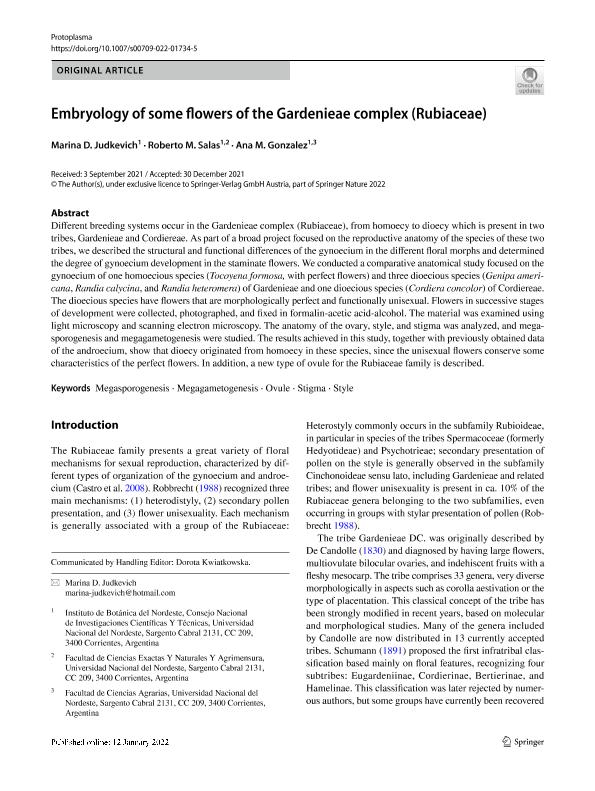Mostrar el registro sencillo del ítem
dc.contributor.author
Judkevich, Marina Daniela

dc.contributor.author
Salas, Roberto Manuel

dc.contributor.author
González, Ana María

dc.date.available
2023-10-09T17:40:24Z
dc.date.issued
2022-01
dc.identifier.citation
Judkevich, Marina Daniela; Salas, Roberto Manuel; González, Ana María; Embryology of some flowers of the Gardenieae complex (Rubiaceae); Springer Wien; Protoplasma; 259; 5; 1-2022; 1233-1254
dc.identifier.issn
0033-183X
dc.identifier.uri
http://hdl.handle.net/11336/214576
dc.description.abstract
Different breeding systems occur in the Gardenieae complex (Rubiaceae), from homoecy to dioecy which is present in two tribes, Gardenieae and Cordiereae. As part of a broad project focused on the reproductive anatomy of the species of these two tribes, we described the structural and functional differences of the gynoecium in the different floral morphs and determined the degree of gynoecium development in the staminate flowers. We conducted a comparative anatomical study focused on the gynoecium of one homoecious species (Tocoyena formosa, with perfect flowers) and three dioecious species (Genipa americana, Randia calycina, and Randia heteromera) of Gardenieae and one dioecious species (Cordiera concolor) of Cordiereae. The dioecious species have flowers that are morphologically perfect and functionally unisexual. Flowers in successive stages of development were collected, photographed, and fixed in formalin-acetic acid-alcohol. The material was examined using light microscopy and scanning electron microscopy. The anatomy of the ovary, style, and stigma was analyzed, and megasporogenesis and megagametogenesis were studied. The results achieved in this study, together with previously obtained data of the androecium, show that dioecy originated from homoecy in these species, since the unisexual flowers conserve some characteristics of the perfect flowers. In addition, a new type of ovule for the Rubiaceae family is described.
dc.format
application/pdf
dc.language.iso
eng
dc.publisher
Springer Wien

dc.rights
info:eu-repo/semantics/openAccess
dc.rights.uri
https://creativecommons.org/licenses/by-nc-sa/2.5/ar/
dc.subject
MEGAGAMETOGENESIS
dc.subject
MEGASPOROGENESIS
dc.subject
OVULE
dc.subject
STIGMA
dc.subject
STYLE
dc.subject.classification
Ciencias de las Plantas, Botánica

dc.subject.classification
Ciencias Biológicas

dc.subject.classification
CIENCIAS NATURALES Y EXACTAS

dc.title
Embryology of some flowers of the Gardenieae complex (Rubiaceae)
dc.type
info:eu-repo/semantics/article
dc.type
info:ar-repo/semantics/artículo
dc.type
info:eu-repo/semantics/publishedVersion
dc.date.updated
2023-10-09T10:35:36Z
dc.journal.volume
259
dc.journal.number
5
dc.journal.pagination
1233-1254
dc.journal.pais
Austria

dc.description.fil
Fil: Judkevich, Marina Daniela. Consejo Nacional de Investigaciones Científicas y Técnicas. Centro Científico Tecnológico Conicet - Nordeste. Instituto de Botánica del Nordeste. Universidad Nacional del Nordeste. Facultad de Ciencias Agrarias. Instituto de Botánica del Nordeste; Argentina
dc.description.fil
Fil: Salas, Roberto Manuel. Consejo Nacional de Investigaciones Científicas y Técnicas. Centro Científico Tecnológico Conicet - Nordeste. Instituto de Botánica del Nordeste. Universidad Nacional del Nordeste. Facultad de Ciencias Agrarias. Instituto de Botánica del Nordeste; Argentina
dc.description.fil
Fil: González, Ana María. Consejo Nacional de Investigaciones Científicas y Técnicas. Centro Científico Tecnológico Conicet - Nordeste. Instituto de Botánica del Nordeste. Universidad Nacional del Nordeste. Facultad de Ciencias Agrarias. Instituto de Botánica del Nordeste; Argentina
dc.journal.title
Protoplasma

dc.relation.alternativeid
info:eu-repo/semantics/altIdentifier/url/https://link.springer.com/10.1007/s00709-022-01734-5
dc.relation.alternativeid
info:eu-repo/semantics/altIdentifier/doi/http://dx.doi.org/10.1007/s00709-022-01734-5
Archivos asociados
